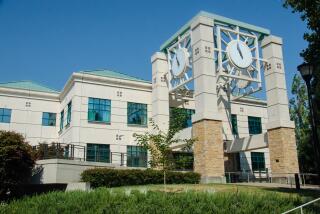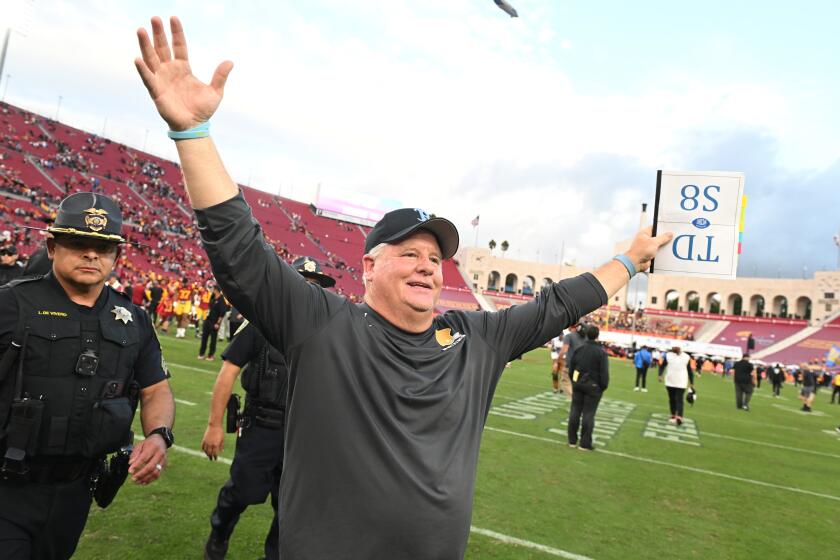Turmoil at SMU: There’s Sentiment Growing to Drop Football
- Share via
DALLAS — If big-time athletics would disappear from this school tomorrow, this school would be a very good school, indeed.
--JESWALD SALACUSE,
former law school dean at SMU
When the wind is out of the south, as it usually is, the aroma at the corner of Mockingbird Lane and Bishop Drive is of bread, rolls and pastries from a huge bakery nearby.
But on the half-mile journey up Bishop, between the trees, dormitories and class buildings into the heart of one of the nation’s centers of higher learning, that tempting scent gives way to the faint odor of deceit, greed and spite. Those smells have become familiar in college athletics, but have come to lay heavily at Southern Methodist University.
“The athletic department,” Dr. James Zumberge, the former SMU and current University of Southern California president, once said, “is the window through which people view your school.”
At SMU, that window is now covered with grime, a condition that enrages the 650 faculty members and 8,000 students. But the business of cleaning it has proved difficult.
As a result, sentiment is growing among an influential and increasingly vocal cadre of academicians to board up the window entirely. If that happens, SMU would become the first major school to abandon football since television turned the sport into a big money-maker.
SMU has been brought to this crisis through a series of events:
--In September 1985, more than two years after the initial report surfaced that SMU boosters paid recruits, the NCAA handed out its sternest football-related probation. In addition to losing television money and the chance to go to bowls for three years, the school was forbidden to recruit any players before the 1986 season and will be allowed only 15 recruits next year.
--Last January, the NCAA adopted legislation allowing it to suspend an athletic program in violation of recruiting bylaws within five years after being placed on probation.
--Last month, additional allegations were brought against the school, suggesting money was paid by a recruiting coordinator to a former player and that a senior on this year’s team had been given a rent-free apartment.
The latest round of suspicion came as the final outrage for those who feel the name of their university had been maligned.
The president of the school, L. Donald Shields, resigned a week after the allegations appeared. Shields suffers from diabetes and said his doctors recommended he retire from public life. SMU’s faculty senate then passed a resolution calling for the abolishment of “quasi-professional athletics” at SMU.
A week later the school’s board of governors ordered all incoming football players adhere to the same academic admission requirements demanded of other students. Board president William Clements, fresh from his successful campaign to again become the state’s governor, announced that decision and said there would be an investigation.
“If we find we must abolish our football program,” said Clements, sounding as if he were still on the campaign trail, “we will. If we can’t bring this program under control, we will abandon it. That is an option.”
A few days later Bob Hitch, the athletic director, and Bobby Collins, the football coach, resigned.
SMU offers undergraduate degrees in 80 courses and has a 14-1 student-faculty ratio. It’s school of theology is well respected, as is its business school and law school. But like so many other universities, SMU is best known to the public for the people who played football there.
For one generation, the school was known for Doak Walker and Kyle Rote. For another, it was Don Meredith. And for still another, Eric Dickerson and Craig James. That, contend those who make academics their life, is not the way it should be.
“I think big-time athletics is one of the problems at SMU,” said former law school dean Jeswald Salacuse. “It saps the strength from the school. If big-time athletics would disappear from this school tomorrow, this school would be a very good school, indeed.
“Forget the corruption part of it. How does athletics facilitate teaching and research? It doesn’t. If anything, it’s an obstacle.”
Such opinions can probably be found in some corner of every campus on which there is major college athletics. But at SMU, those comments are being heard more and more because those who have for years harbored jealousies and outright dislike for athletics now see their chance to rid the school of them.
SMU is without a football coach in the midst of recruiting season. It is without an athletic director. It is without a president--the previous one being a big football fan.
The faculty senate has urged no athletic director or coach be hired until a committee finishes its investigation into the “role of athletics on this campus.”
Members of the athletic department have been shocked at the venom aimed at them. And they are puzzled by the fact the attackers have used academics as their theme.
Two days before he resigned, Hitch spoke to the faculty senate in hopes of calming their fears concerning academic progress.
“The NCAA now demands an accounting of graduation rates from every member institution,” Hitch said. “When we supply these rates, they take into account everybody who completed his or her eligibility. If they went on to play professional sports and didn’t graduate, that counts against our graduation rate.
“For the class that entered SMU in 1981, we had a 78% graduation rate in the athletic department.”
The school’s chief admissions officer, who attended the same meeting, said the overall average graduation rate at SMU is 75%. Such figures do not seem to impress the faculty.
When interim president Dr. William Stallcup announced suspension of “special admissions” for the football team, applause broke out among the professors attending the news conference.
The bitterness between the faculty and athletic department verges on a civil war--with most of the shooting coming from the academic side--that has drawn in the student body.
The student senate adopted a resolution, 25-6, urging punishment for school officials who knowingly break NCAA violations.
“I think the students during the past few weeks have felt the integrity of the institution has been compromised,” said student body president Trevor Pearlman, a third-year law student.
“I’m disgusted with the student senate,” said freshman member Scott Smoyer, who voted against the resolution. “What we’re doing is just showboating for the media. I know the freshman class is going to be hurt next year if we don’t have a football team.”
The five students who voted against said no one should be considered guilty until shown otherwise.
The squabble could be a long one. As it proceeds, these points will come into play:
--The most recent allegations have not been proved. There are indications the contention of former player David Stanley that he received money previously has been considered and dropped by the NCAA. Additional NCAA sanctions could be minor.
--Almost all of SMU’s problems stem from outside influences, including alumni who have disregarded NCAA rules in helping football players. Rather than the athletes discrediting the university, it has been prominent members of the business community. The athletes, however, are the ones who have suffered while the NCAA and SMU have refused to list the boosters who helped bring about the current probation.
--There is the possibility the private university might lose big donors if the athletic department is disbanded. “SMU people have a history of rallying together in times of trouble,” said one fund raiser. “We hope that will be the case this time. But you don’t know.”
--A cry will likely be raised by civil rights advocates suggesting the elimination of special admissons (students who have lower SAT scores than the average student) discriminates against minorities.
“If we go back to saying we should not admit student athletes who would otherwise not be admitted, it would end opportunities for many black students,” NCAA secretary-treasurer Wilford Bailey said at a forum sponsored by the Southern Assn. of Colleges and Schools. “What’s happened at SMU is a human tragedy.”
That tragedy has affected lives from the president of the university to the third-string defensive tackle on the football team. Academics vs. athletics is a confrontation that takes place at school after school. But at SMU, that confrontation has developed into a major brawl--one that will determine the destiny of not just the athletic department, but the school itself.
More to Read
Go beyond the scoreboard
Get the latest on L.A.'s teams in the daily Sports Report newsletter.
You may occasionally receive promotional content from the Los Angeles Times.






